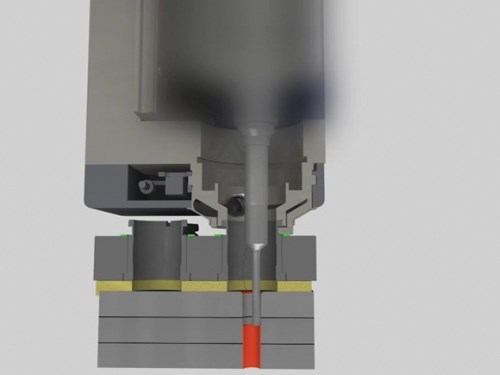Orbital Drilling enables “one-up assembly”
Orbital Drilling, a technology patented by Novator AB (Spånga, Sweden) offers multiple hole sizes from a single drill tool.
Share
Orbital Drilling, a technology patented by Novator AB (Spånga, Sweden), is based on rotating a cutting tool around its own axis and simultaneously around an offset center axis. Thus, the cutting tool can move simultaneously in an axial direction to drill or machine a hole and navigate horizontally (like a router tool) to machine an opening or cavity larger than the tool’s diameter. By calculating an offset, and moving the spinning tool in a circular motion, a single cutting tool can be used to drill holes of any diameter larger than the tool’s diameter. This can substantially reduce cutting tool inventory and tool changeover frequency. Orbital Drilling units with CNC-controlled offset make it possible to drill a complex-shaped hole and perform finishing operations with the same diameter tool and setup. Thus, the need for specific tools for additional tasks is greatly reduced because Orbital Drilling also can be used for adaptive stack drilling, cutting returns, countersinking and reaming.
According to Eleanor Merson, Sandvik Coromant’s Sheffield, U.K.-based R&D manager, this technology also offers dust-free drilling, which is important for hollow components made from several different pieces. Such modules are assembled, then drilled and machined. With Orbital Drilling, a vacuum system can be linked to the back end of the tool to remove the dust, which eliminates disassembly and reassembly for cleaning. This is reportedly not possible with traditional drilling tools because there is not enough open space to create a vacuum. Orbital Drilling also produces a sickle-shaped end cap, which gets broken off and sucked away, compared to a normal drill’s smaller circular end cap, which typically falls into the assembly.
Aircraft manufacturer Airbus (Toulouse, France) reportedly increased its annual flap assembly rate from 30 to 300 units on its A321 by using an automated riveting of closed structures (AROCS) machine with an Orbital Drilling end unit that drills through both the flap skin and frame components in a single pass, without having to disassemble it for deburring and cleaning. Subsequently, Airbus adopted Orbital Drilling for flaps on all its commercial aircraft models.
Novator CEO Hans-Petter Andersson adds that Orbital Drilling enables “dry drilling” using air cooling to eliminate the need for liquid coolant: “Not only is this more environmentally friendly and cheaper (no cleanup), it is also much safer for the operators.” Andersson lists several current case studies. Six portable Orbital Drilling units are used today on The Boeing Co.’s (Seattle Wash.) 787 Dreamliner wing-to-body (WTB) fairing, and another 59 will be delivered in 2012, with the aim of using only this type of machining on the WTB fairing’s CFRP/titanium stacked construction. Bombardier (Montréal, Québec, Canada) also will use Orbital Drilling on the CFRP/titanium WTB fairing of its CSeries passenger jets when production commences.
Related Content
-
Thermoplastic composites welding advances for more sustainable airframes
Multiple demonstrators help various welding technologies approach TRL 6 in the quest for lighter weight, lower cost.
-
Carbon fiber in pressure vessels for hydrogen
The emerging H2 economy drives tank development for aircraft, ships and gas transport.
-
Novel dry tape for liquid molded composites
MTorres seeks to enable next-gen aircraft and open new markets for composites with low-cost, high-permeability tapes and versatile, high-speed production lines.




.jpeg;maxWidth=150;quality=70)







.jpg;maxWidth=300;quality=90)
